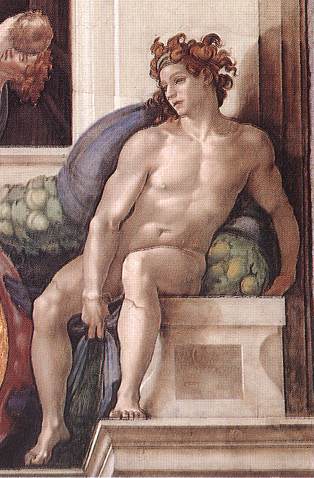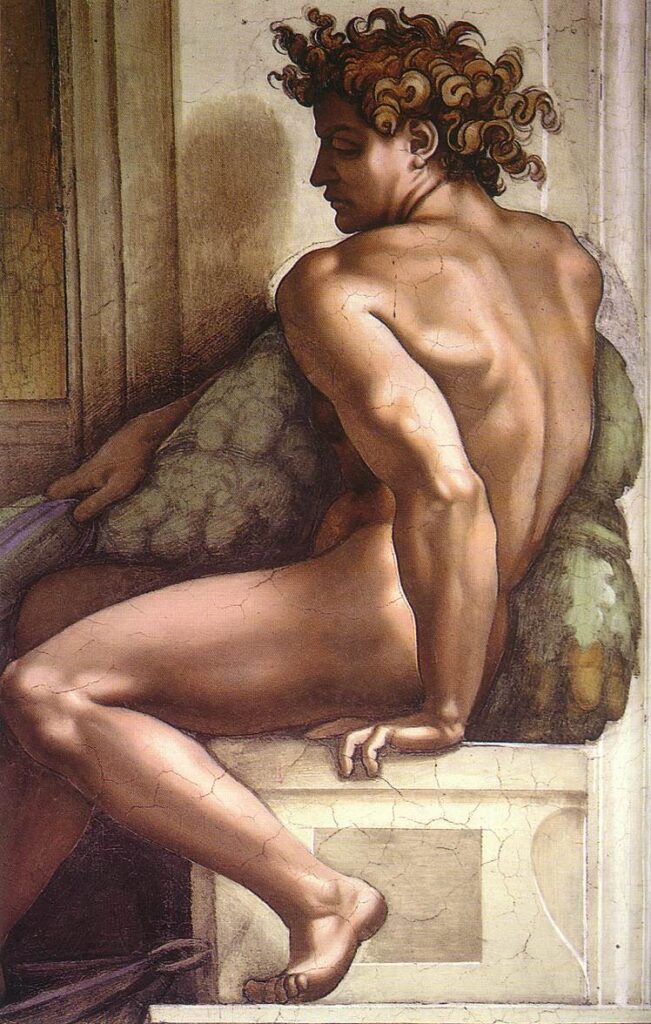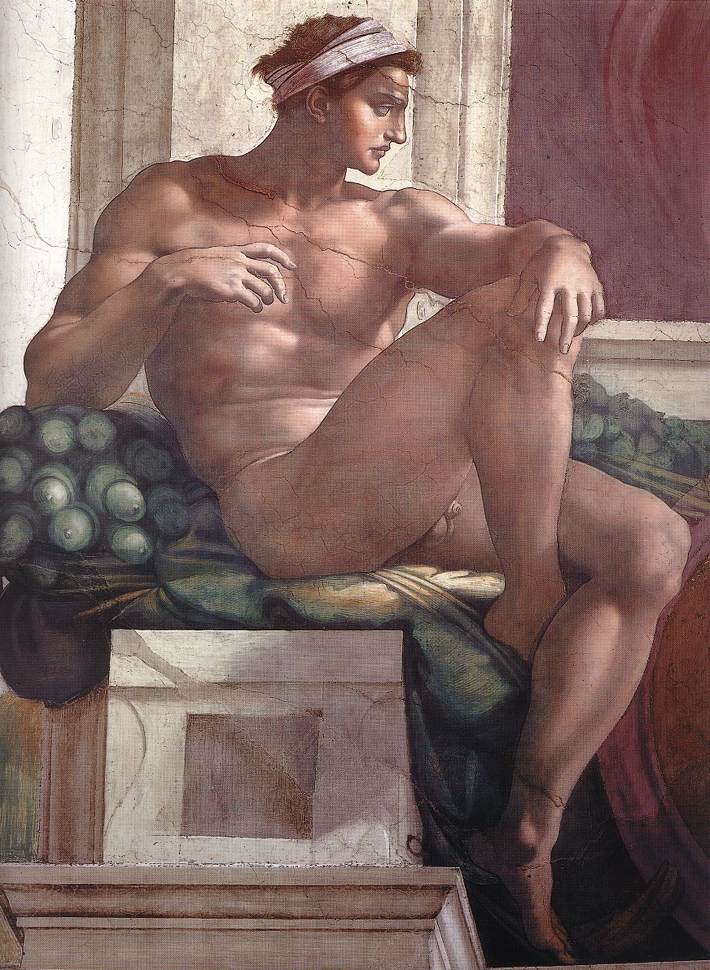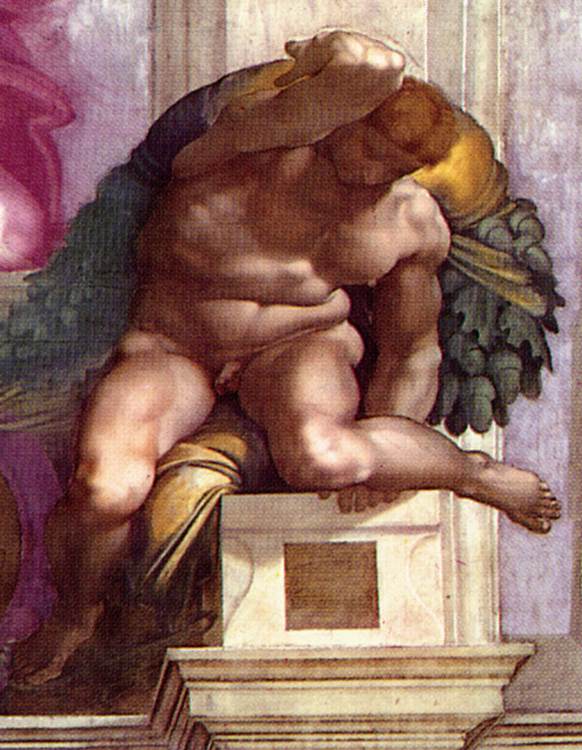When, in the mid-’70s of the fifteenth century, Sixtus IV decided to rebuild the Cappella Magna, the palatine chapel of the Apostolic Palace, he still did not know exactly what it would look like, let alone that one day it would take his name, but he knew he wanted it to be magnificent and able to impress the other powerful people of the time by transmitting the renewed greatness of the papacy. He left only the butts of the perimeter wall standing and rebuilt everything else from scratch until he obtained what today, seen from the outside, looks more like a late medieval fortification than a church.
Inside the long side walls enjoy the benefits of the dignifying reconciliation between the papacy and Florence after the Pazzi incident (Lorenzo de’ Medici agreed to “lend” the Pope artists such as Botticelli, Rosselli and Ghirlandaio as well as Pinturicchio and Di Cosimo among the helpers) but the decoration had already begun at the hands of two Umbrians. Perugino had been entrusted with the execution of an Assumption of Mary at the centre of the back wall, a work that would be swept away by Michelangelo’s Judgement and of which only a drawing by Pinturicchio remains
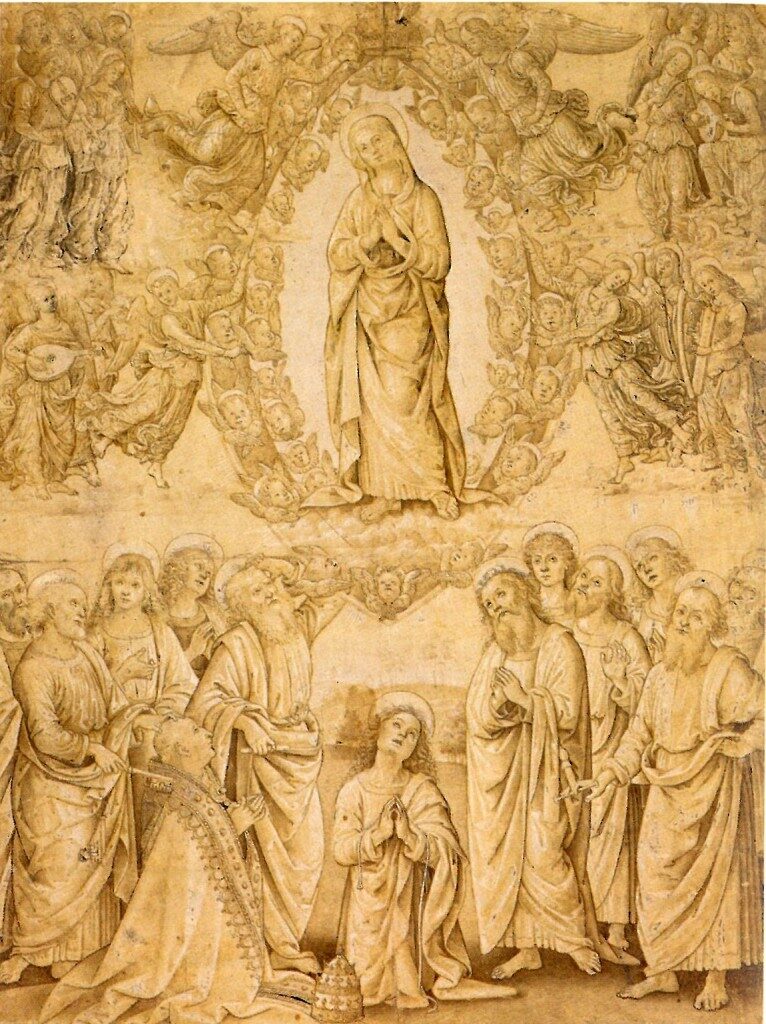
flanked by a Birth and Finding of Moses and a Nativity of Christ already consistent with the general iconographic project that foresaw stories from the Old Testament on one side and the Gospels on the other and that evidently must have already been drafted and approved.
The vault, on the other hand, was entrusted to the lesser known Piermatteo d’Amelia, a former collaborator of Perugino, who had created a starry sky. The 1899 lithograph by Gustavo Tognetti that you can find on wikipedia indicated as “Reconstruction of the appearance of the Sistine before Michelangelo’s interventions” is completely imaginary because the Uffizi has a preparatory drawing of Amelia’s (Gabinetto dei Disegni e delle Stampe, architectural drawing n. 711) that shows what the vault must have looked like:
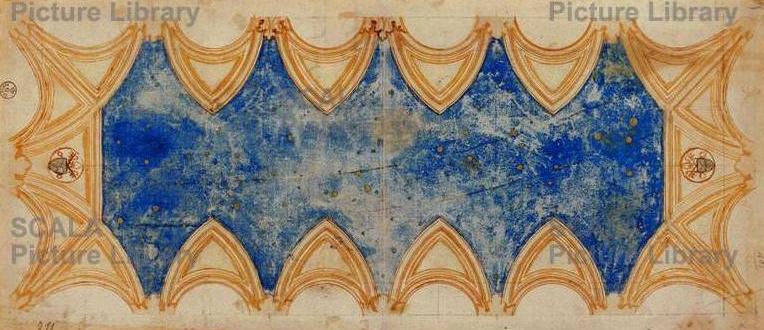
The distribution of the stars in fact, contrary to the classic medieval star vaults, appears irregular and asymmetrical as if it reflected a portion of the real sky. Personally, I find it difficult to think that this arrangement was the result of chance and I tend rather to suspect that it was a natal chart forerunner of the more abstract one frescoed by Baldassarre Peruzzi in Agostino Chigi’s Villa Farnesina, a sort of snapshot of the celestial vault when an event (typically the birth) of the client occurs.
Pope Sixtus’ passion for astrology/astronomy (at the time the boundary had not yet been precisely drawn) contributed to this hypothesis, a passion in any case widely shared with the good society of the time. It seems that he himself dabbled in astrology and in 1475 he called the famous astronomer Johannes Müller, commonly known as Regiomontanus, to Rome to work on a reform of the calendar. Müller died a few months after his arrival but perhaps he had time to write the theme for the pope or perhaps to provide the pope himself with the rudiments to calculate it himself. A few years later he also became protector of Lorenzo Bonincontri, entrusting him with the chair of Astrology at the Studium Urbis, the original nucleus of the future Sapienza university.
Unfortunately, I know almost nothing about astronomy and I am therefore not in a position to do research on it, but let’s say that I would not be too surprised if that drawing represented the sky as it was on 21 July 1414, the date of the birth of Sixtus IV, or perhaps on 25 August 1471, the day of his election to the papal throne1
In 1504 a section of the shoe base under the south wall gave way and caused a long crack2 to open on the starry ceiling that would take several months of work to close, but the scar on the fresco was the drop that overflowed the vase of Julius II and definitively unleashed his desire to leave a mark in the main chapel of the Palace wanted by his uncle Sixtus. That ceiling had to be rebuilt and to do it again the Pope chose an artist just over thirty years old but who was already a star. The characters of the two had already had the opportunity to test each other: on May 10, 1508, the day on which Michelangelo received 500 ducati in advance for the Sistine vault, was preceded by stormy years regarding the relationship between the artist and Julius II. In 1505, in fact, the pope had approved the project for his tomb drawn up by Michelangelo, who had gone to the quarries of Carrara to personally choose the blocks for the work and remained there for eight long months during which his Roman enemies, who were not few, worked on Julius’ side, making all kinds of excuses. It is said that Donato Bramante, head of the St. Peter’s factory, even went so far as to argue that it would have been a bad omen to make the tomb while alive and in the midst of a myriad of such important commitments, but much more likely is that the generous allocation of funds reserved for the tomb (10,000 ducati) was affected by a sudden reversal in favour of other works such as the new basilica and the apostolic palace as well as the renewed skirmishes in arms against Perugia and Bologna.
Buonarroti thus returned to Rome where he learned that the tomb, for the moment, was no longer being used3.
For months he tried in vain to be received by the Pope for a clarifying audience, but he was ignored on April 18, 1506 and packed his bags to return to his Florence from which, in August 1504, he had received the commission to fresco the wall of the hall of Palazzo Vecchio with the Battle of Cascina, but his Battle would make even less progress than that of Leonardo on the opposite wall. The following year Julius II made his peace with the equally angry Michelangelo and, thanks to the promise of a substantial advance payment4, convinced him to work on the decoration of the vault.
The layout initially envisaged only the twelve apostles in the position where the Veggenti (Seers) are today, while the rest would be filled with geometric decorations. Of this phase we are left with two sketches preserved respectively at the British Museum
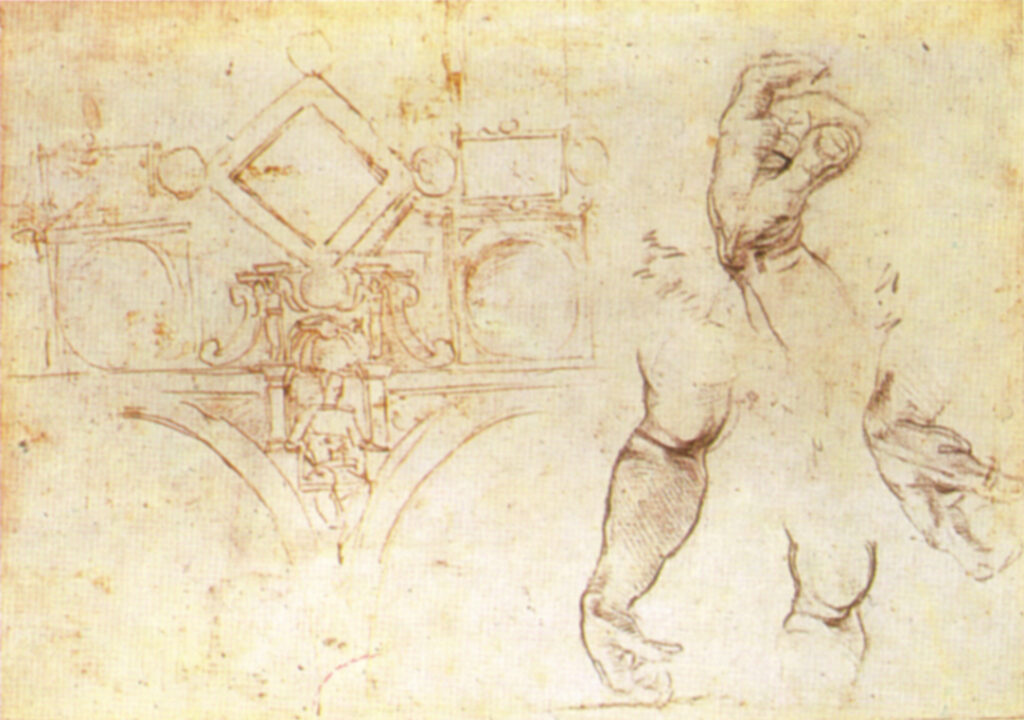
and at the Detroit Institute of Art
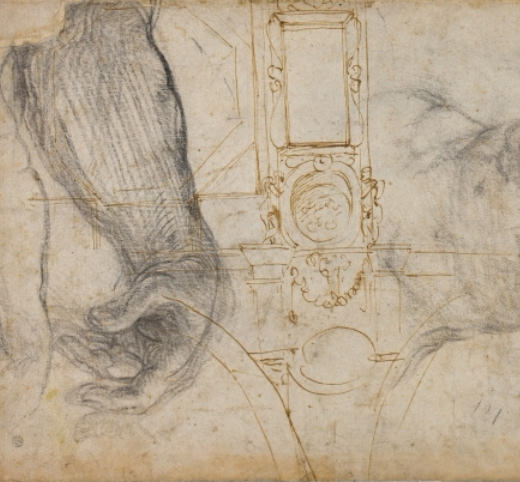
Michelangelo somehow managed to persuade him that the work would be quite miserable so that Giulio, strangely enough, left him carte blanche, or at least so the artist asserts in his letter to Giovan Francesco Fattucci of 30 November 1523:
“The first drawing of his first work were twelve Apostles in the lunettes, and the rest a certain part filled with adornments, as is customary. Afterwards, when I had begun the work, it seemed to me that it succeeded as a poor thing […]. So he gave me a new commission that I should do what I wanted and he would have pleased me“
So the idea of representing humanity ante legem to close the circle of the tripartition ante legem/sub lege/sub gratia5 which already saw the second part represented in the cycle of the Old Testament and in the one of the Gospel on the side walls, could have been Michelangelo himself who, according to one of the possible explanations, had already used it in the famous Tondo Doni painted a few years earlier. In the Tondo in fact the nudes in the background could represent the ante legem and his life in the state of nature, Joseph and Mary the sub lege and the child Jesus the fulfillment of sub gratia.
This is why I dwelt first on the querelle of the tomb. The material accumulated for the project of the monument comes alive in the new design of the frescoes: a majestic architectural structure populated by titanic, powerful, plastic and tactile figures, painted as if they were sculptures in a blaze of niches, pilaster strips, friezes, frames and reliefs while blowing up the bench of the rigid Renaissance perspective, putting the monumentality of the individual figures before these elements rather than the opposite (“accommodating more the partition to the figures than the figures to the partition” Vasari wrote). It is as if he said to the pope “From me you will have the extraordinary, whether you want it or not” and as far as we know he would also have been capable of it.
Michelangelo was never one to waste time: on May 11, the day after receiving the down payment from the pope, he in turn paid an advance of ten gold ducati to “Pietro di Jacopo Rosselli, master of walling” to “isolate the vault of Pope Sixtus and curl and do what needs to be done”. The scaffolding and the execution of the arriccio took place between May 11 and July 27, the date of payment for the balance of the preliminary works. Rosselli also took care of the scaffolding (one was built to a design by Bramante but Michelangelo did it in his own way) of which we do not know the exact shape but which exploited the 15th century putlock holes on the sides of the windows in the side walls.
When things were done it must have looked like this drawing by Michelangelo himself so that he could cover the entire stretch of vault between the two walls, a drawing that also inspired the scaffolding used between 1980 and 1990 for the historic restoration:
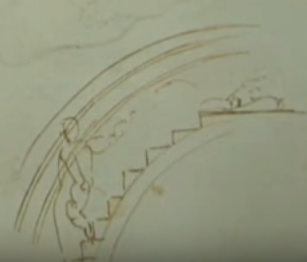
It was the beginning of 1509 when the helpers began to lay the arriccio and nail the cartoons but the beginning immediately posed both technical and stylistic problems. The plaster, which was too damp, tended to become mouldy and the first panel made, the Diluvio Universale (Universal Flood), perhaps did not satisfy him because of some mistakes made by the helpers whose role, however, including the trusty Granacci and Bugiardini, gradually decreased as the work progressed. The people saved on the rock will be the first figures to be painted on the vault and the only ones to be saved from the destruction of the box for an almost complete remake. Note that of the whole group only the old man with his dead son in his arms on the left is entirely in Michelangelo’s hand.

While the mould problem will be brilliantly solved by creating a new plaster mixture, the stylistic one will impose a fairly radical change of register. From the crowded and indistinct mass of the Flood, in the following scenes (Noah’s Sacrifice/Drunkenness) the figures will begin to diminish in number and become larger and more present, less static and more charged with dramatic dynamism as if Michelangelo at the beginning still had some doubts about the abandonment of conventional paradigms, doubts of which he is quickly freeing himself from the first months.
Even the visionaries are affected by this effect. Proposing them in what was probably their order of execution helps to better see this progressive shift from a relatively canonical approach to much greater freedom and variety:
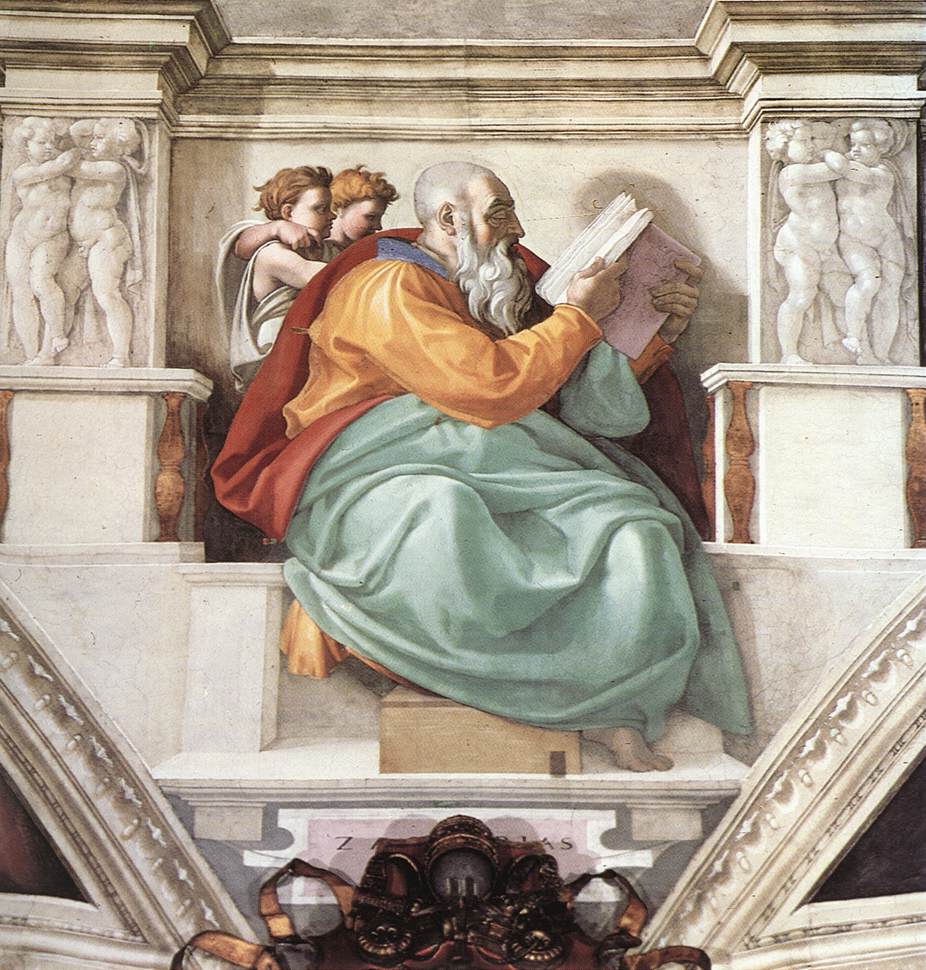
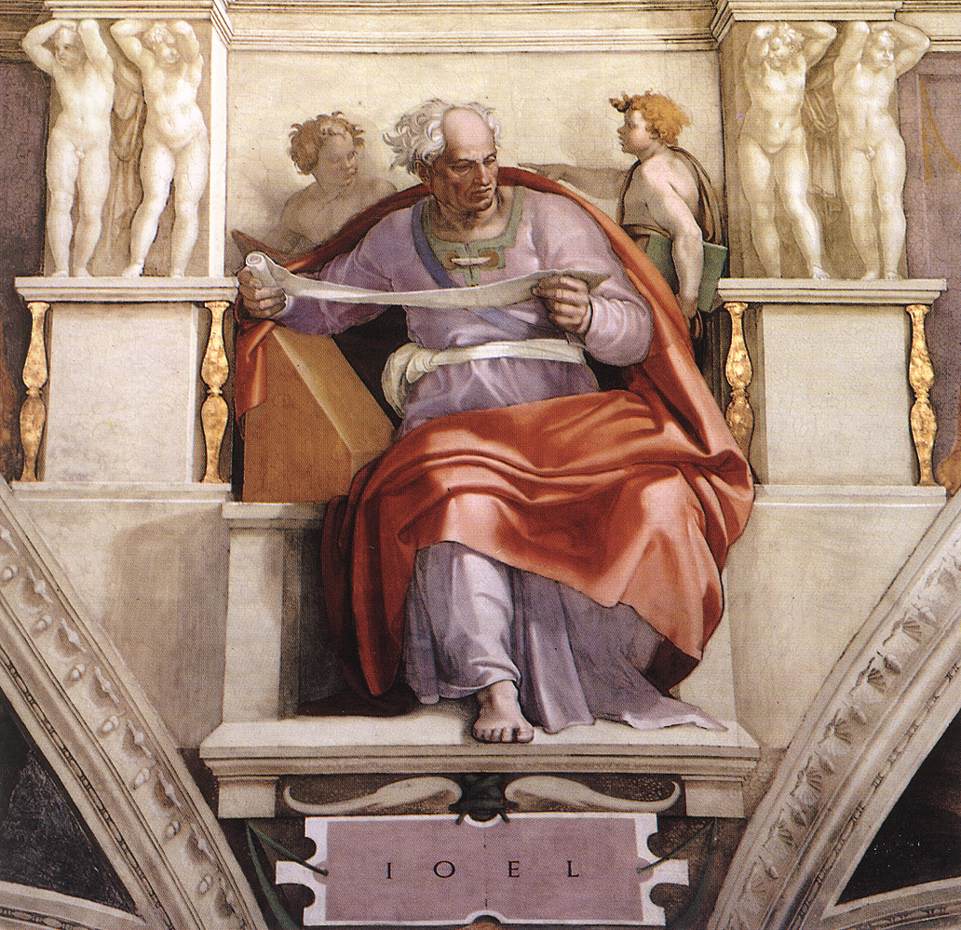
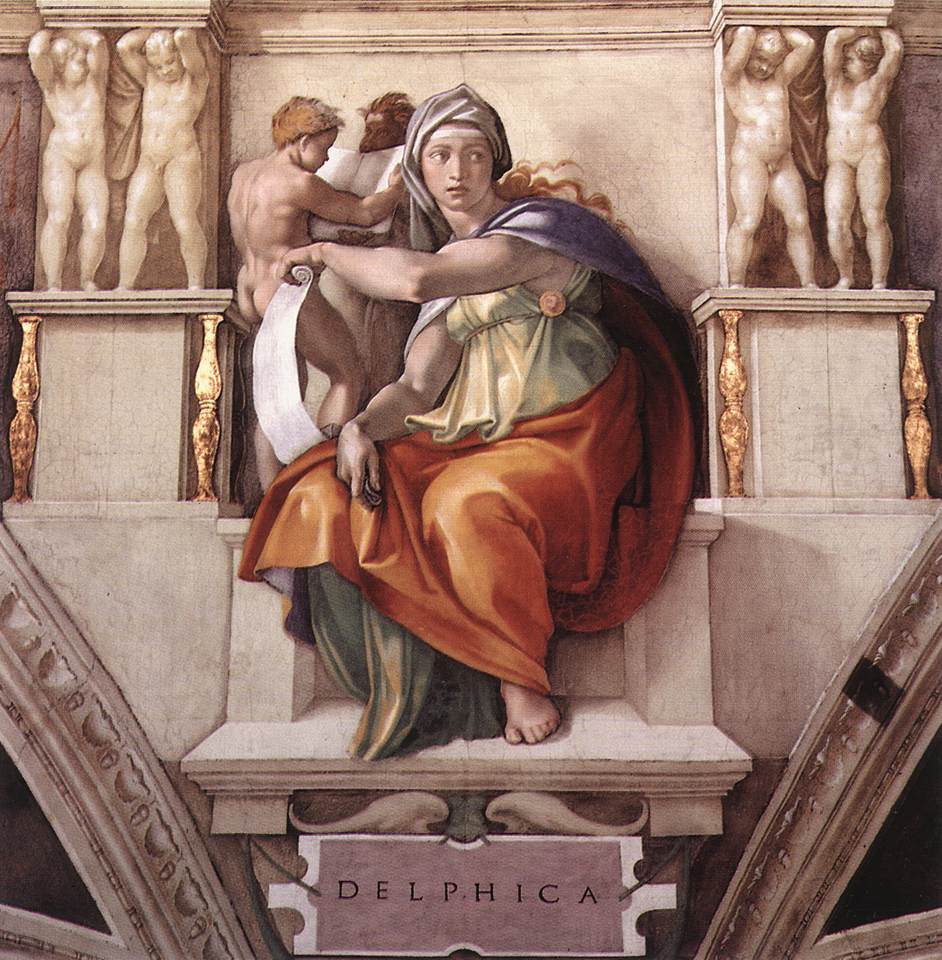
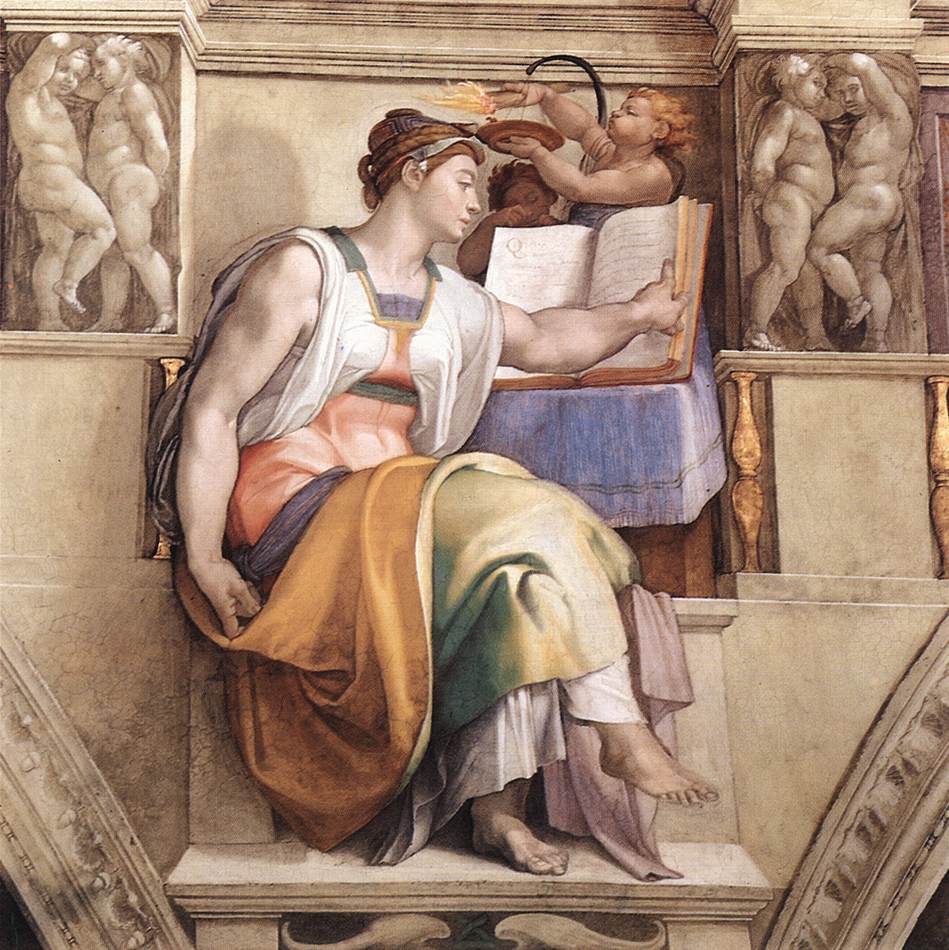
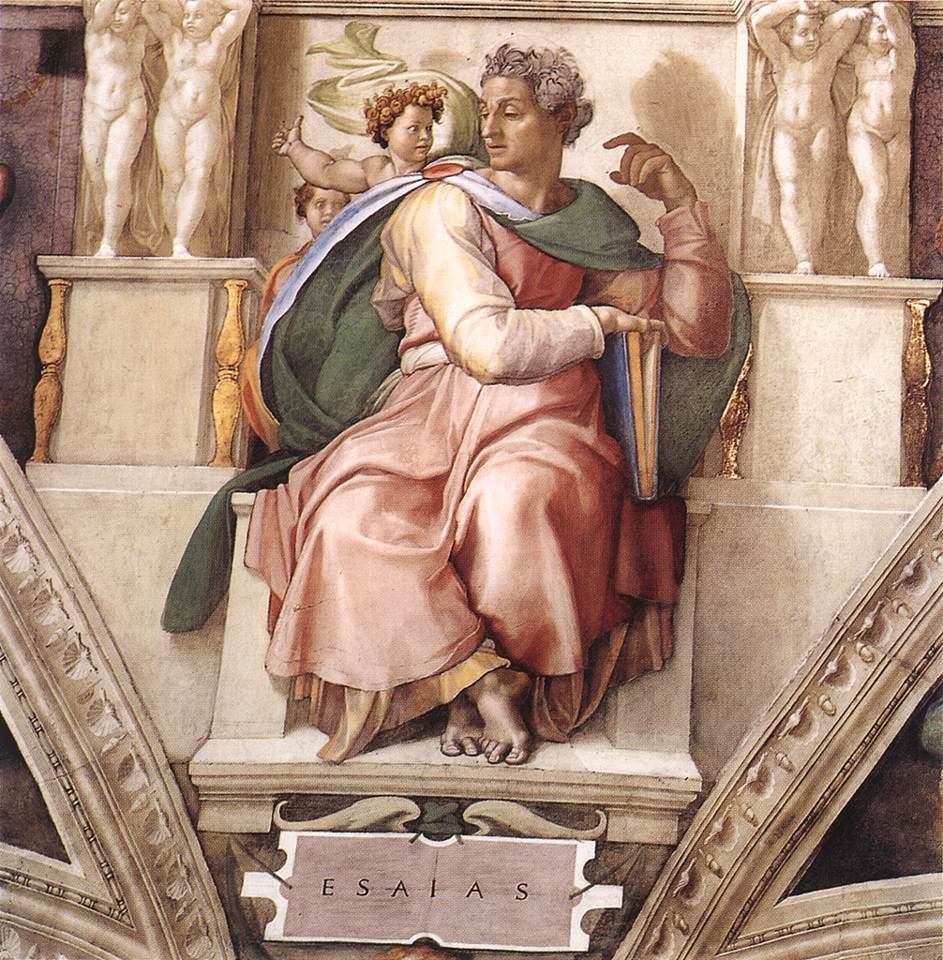
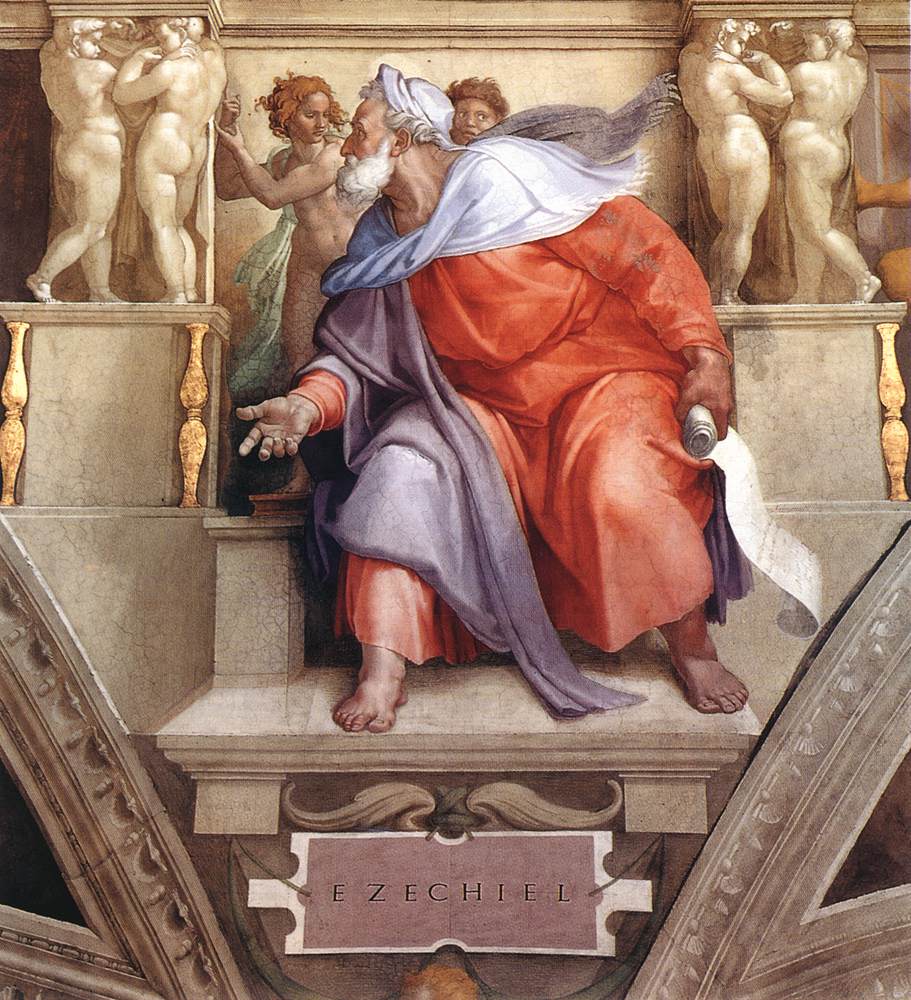
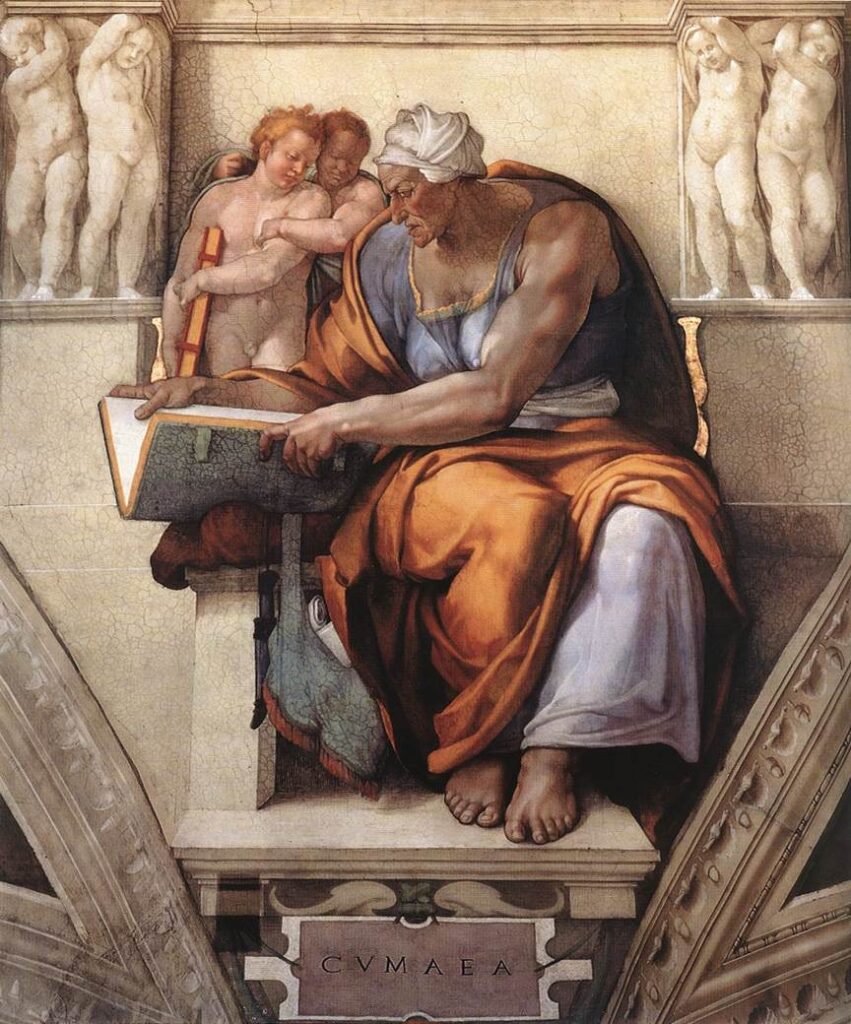
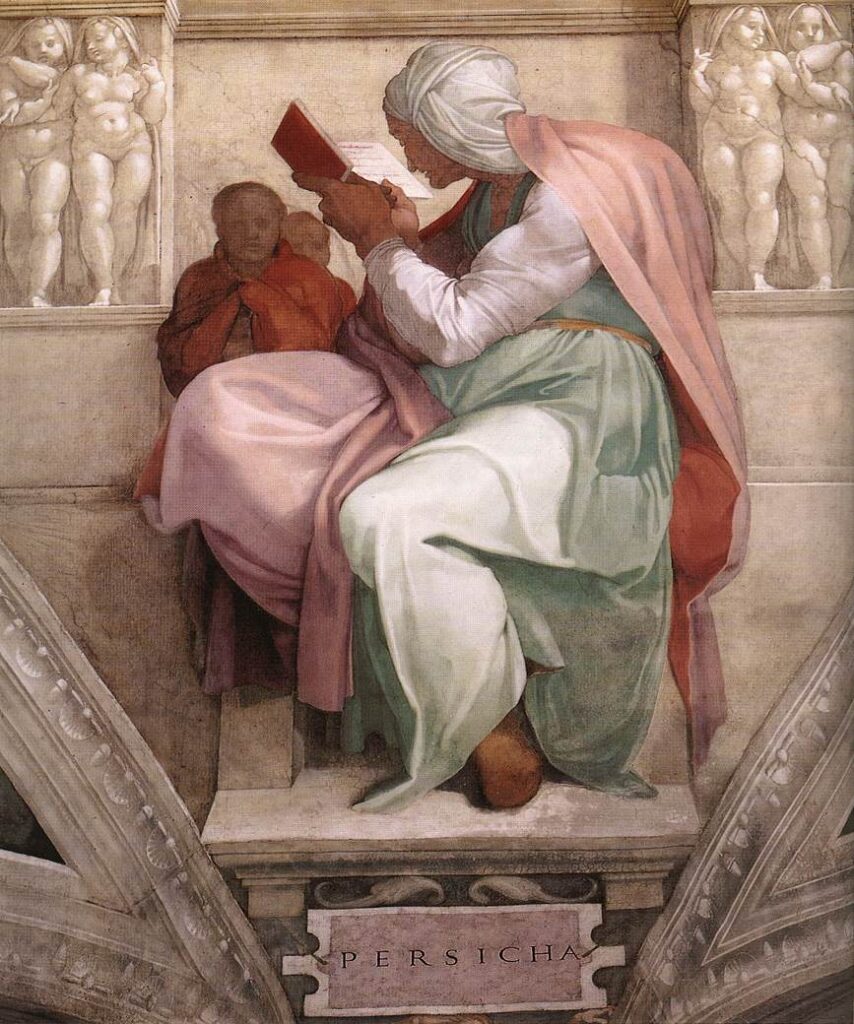
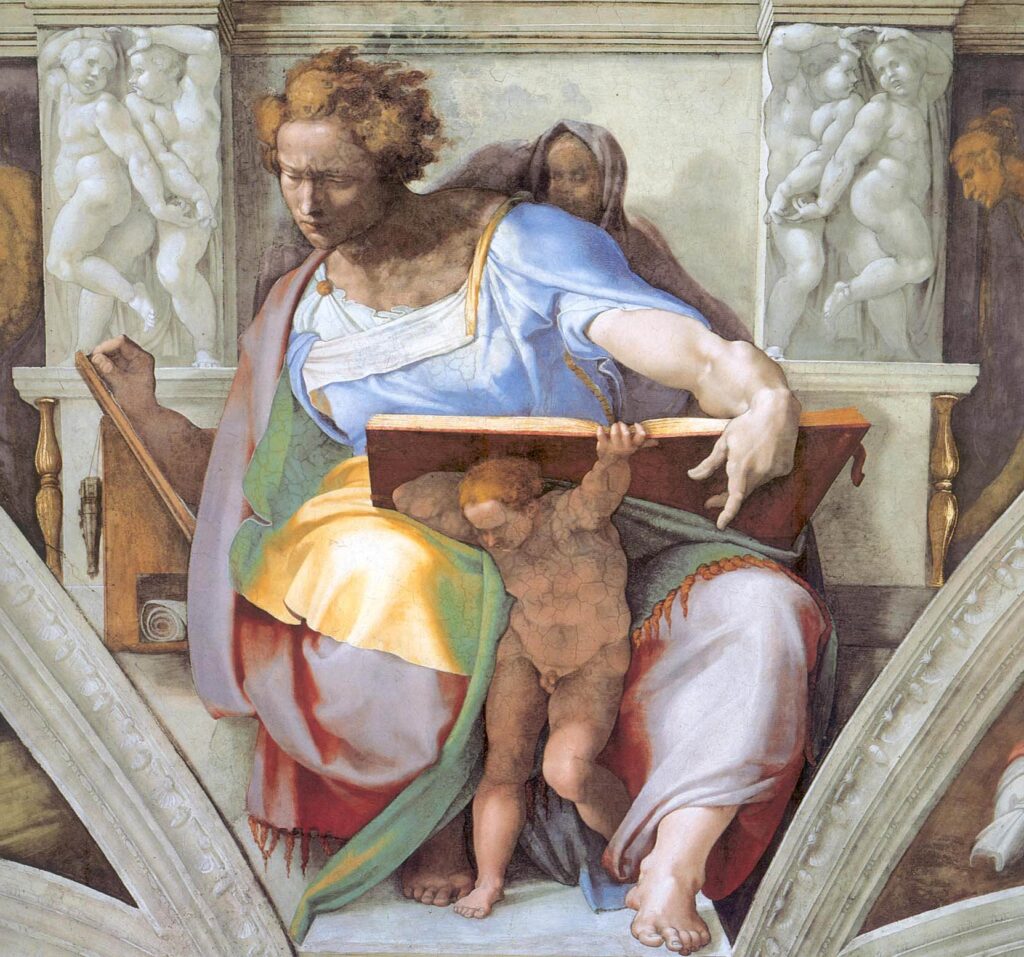
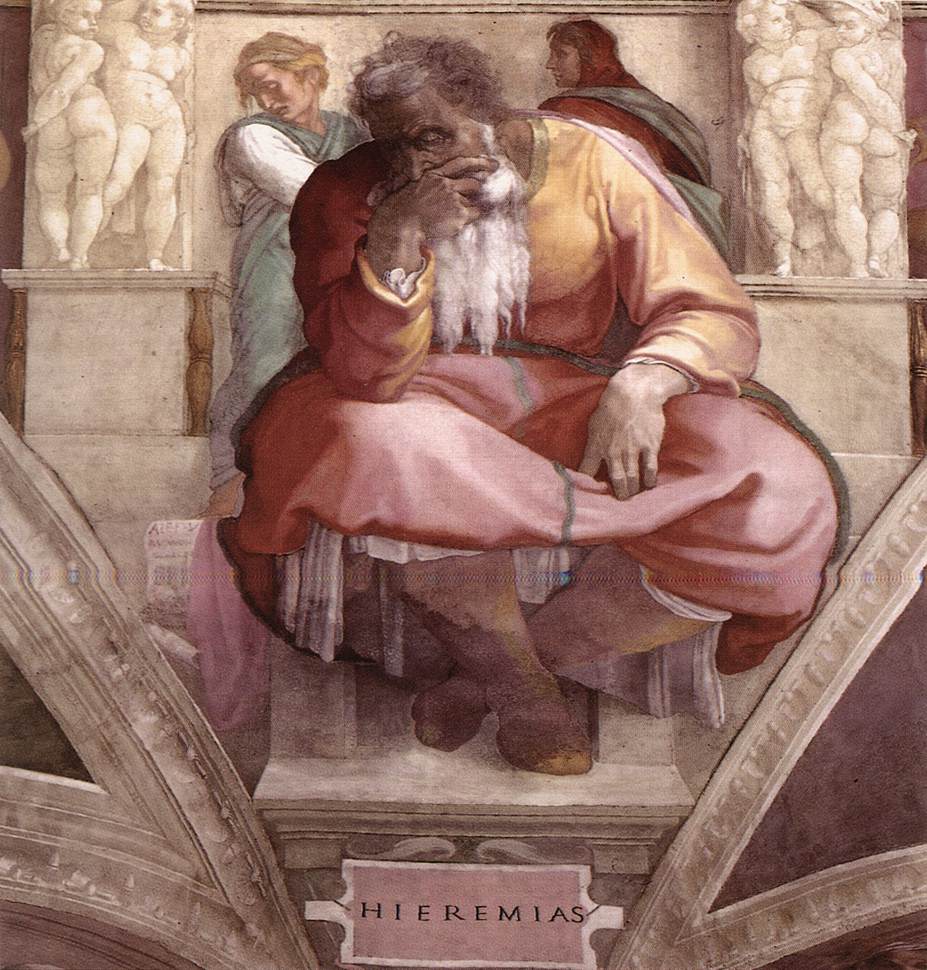
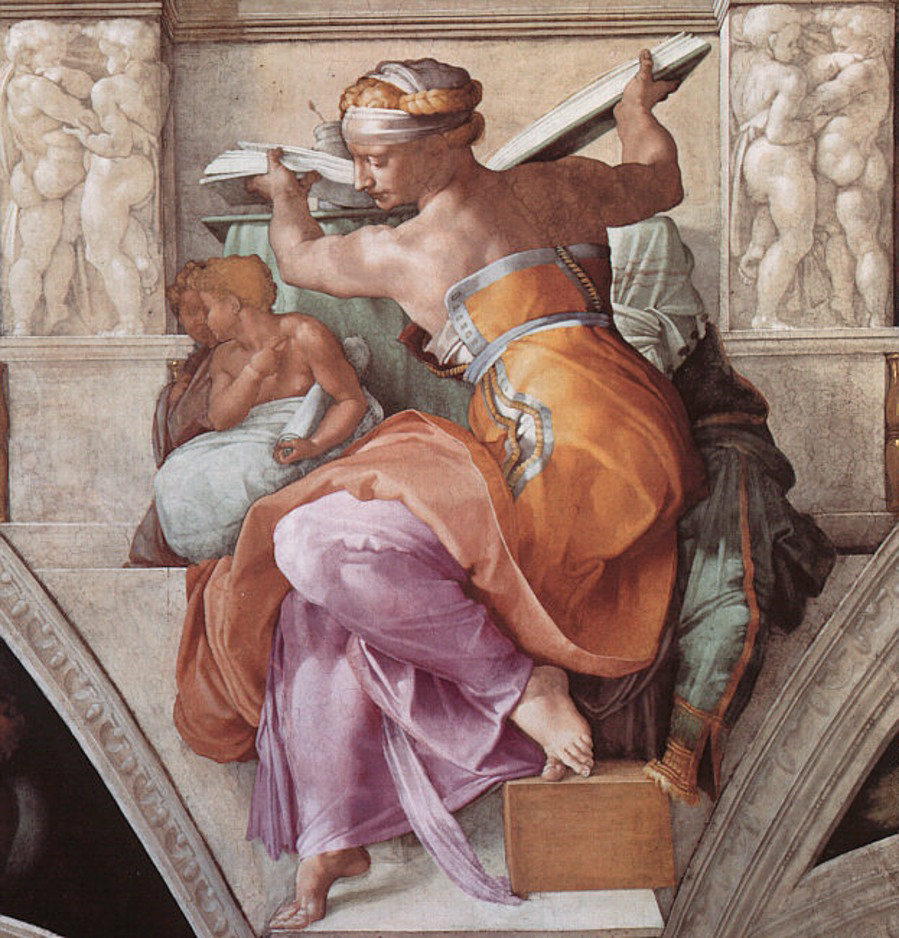
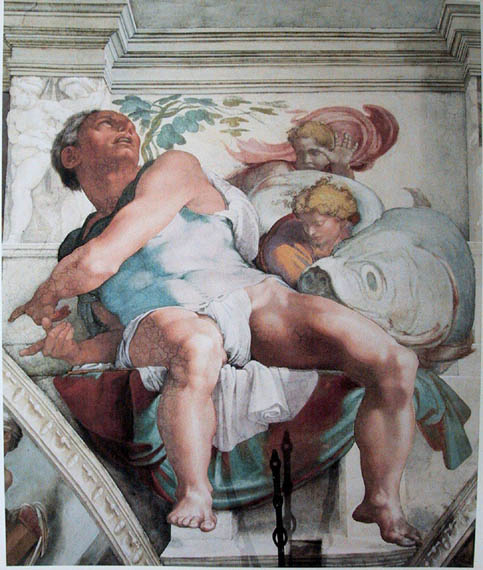
The same fate falls to the ignudi (“naked”), bizarre figures halfway between the human and the divine, angels in demon poses who, as the work progresses, become both larger and endowed with a greater variety of attitudes and expressions.
The former:
the last ones:
From a certain point on, Michelangelo increasingly raises the bar of inventiveness and dynamism with twists that, in fact, invent mannerism and at times even prefigure the Baroque. Curiously, this race to overcome the ideal of harmony and balance of the Renaissance has its probable root in one of the symbols of classicism that was so dear to the creators of the time, that group of the Laocoon that came to light a few years earlier and immediately became the object of almost sacred adoration and source of inspiration.
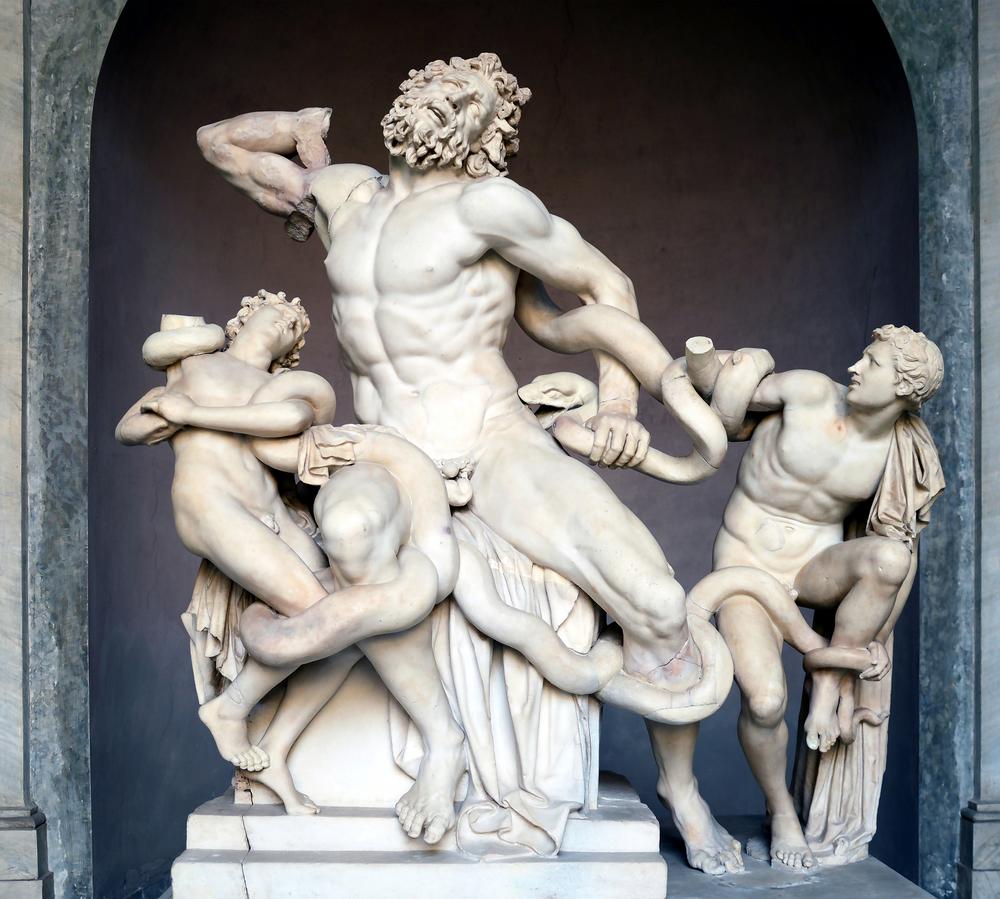
Thus the spasms of Hellenistic characters become irrational and wild twists like those that animate the Bronze Serpent scene

The comparison with the serene hyperclassicism of Raphael, who in the same years worked in the Stanza della Segnatura, could not be more strident. That the two human types were very different, and that they also had a very different way of managing competitiveness, is a well-known fact, but they knew and respected each other, and an ideal parallel can be drawn between the two, thinking that both of them, even with a pope like Julius II on their back, who was certainly not known for his patience, and in contrast to the workshop practice widely in use at the time (which involved extensive recourse to help with the master concentrating on the general layout and a few fundamental figures), they did most of their work alone and both their creations were very much loved by the pope, which perhaps also tells us something about this personality that the chronicles have a tendency to report as granitic and one-dimensional.
From 1508 to 1512, except for a few interruptions, Michelangelo painted standing or lying down, but always with his head upwards in a strenuous and unnatural position, to the point that, for a few months after the end of the work, to read or look at a drawing he was forced to hold the sheet of paper raised above his head and look up. He gives account of this in a sonnet for a friend of Pistoia in which he portrays himself at work in the form of a barely sketched caricature
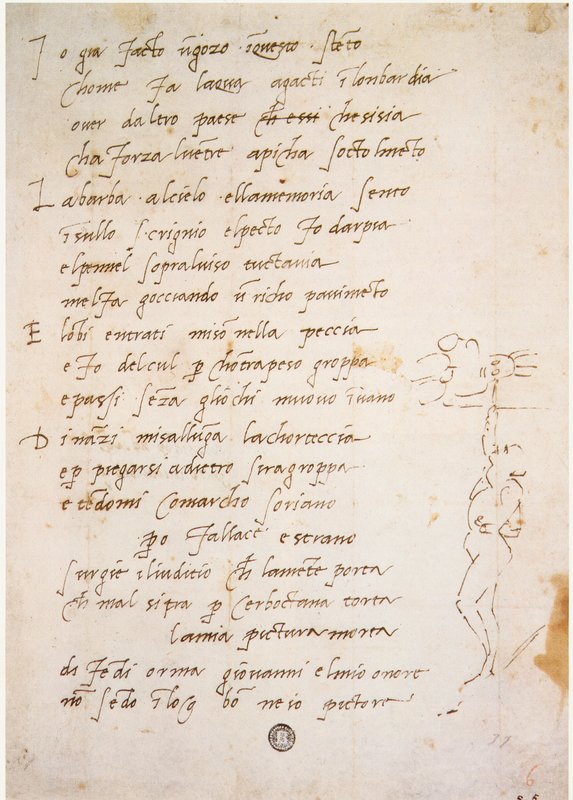
The text deserves to be reported in full because, although in a playful tone, it gives account of the tension, even physical, to which Michelangelo was subjected in those years (translation is coming from here)
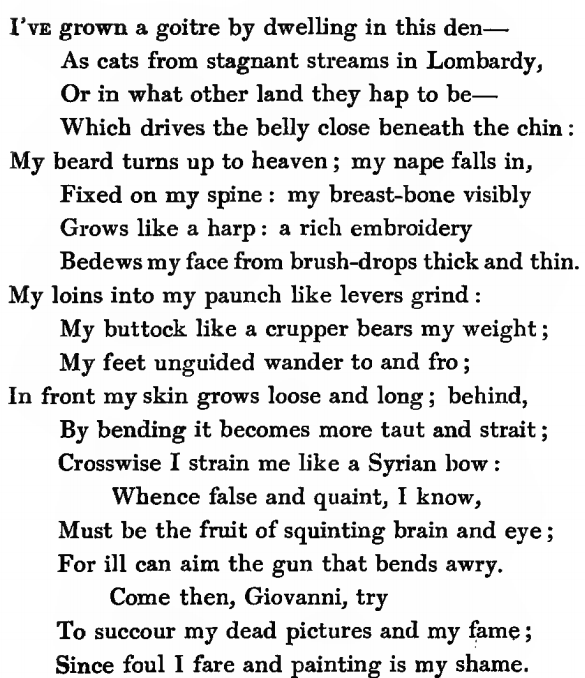
On October 31 1512 the Papal Ceremonier Paride Grassi6 noted “Hodie primum capella nostra pingi finita aperta est” (“Today for the first time our chapel, finished painting, is open”). When the pope, with a queue of cardinals, nobles and artists behind him, enters the chapel as soon as it is finished, the effect is disruptive. Very rarely does history, whether of art or otherwise, resemble a series of straight lines that change direction hinging on precise and defined points in time and space, but if these points exist (and some, at least in a certain sense, do) that October 31 is definitely one of them. Michelangelo came out victorious from his melee with the ghosts of classicism led by Laocoonte. He won by using them, introjecting them spiritually and intellectually to a depth that has few comparisons even in that era full of learned exegetes; he catalyzed them, chewed them up and spit them out on that time that still today, even if on average reduced to a devotional saint and destination of distracted pilgrimages, if observed in the right way, is one of the most precious inheritance of that unrepeatable season that was the Renaissance.
Many years later, in 1536, an unexhausted sixty-one year old Michelangelo made an even more radical leap both in style and theological implications by tackling the back wall commissioned by Clement VII and Paul III. There will disappear all traces of the already bland architectural illusionism staged in the vault, no panels, no scans, just a mass of muscles and faces that seems to rotate on itself in an immense vortex that has as the eye of the cyclone a terrible and very little reassuring Christ, surrounded by saints, saved and submerged souls and angels without wings colleagues and direct descendants of the naked on the vault.
It is curious, to say the least, that one of the most famous monuments of Christianity was created by an artist who, because of his closeness to the Spirituali circle, inclined to see the Reformation in a good light, took a big risk with the Inquisition, but this is a subject we will deal with another time.
But let’s finally see them together the creators of these wonders: Sixtus IV and Julius II, uncle and nephew, portrayed in 1477 by Pictor Papalis Melozzo da Forlì in a fragment of a fresco now preserved in the Vatican Museums.
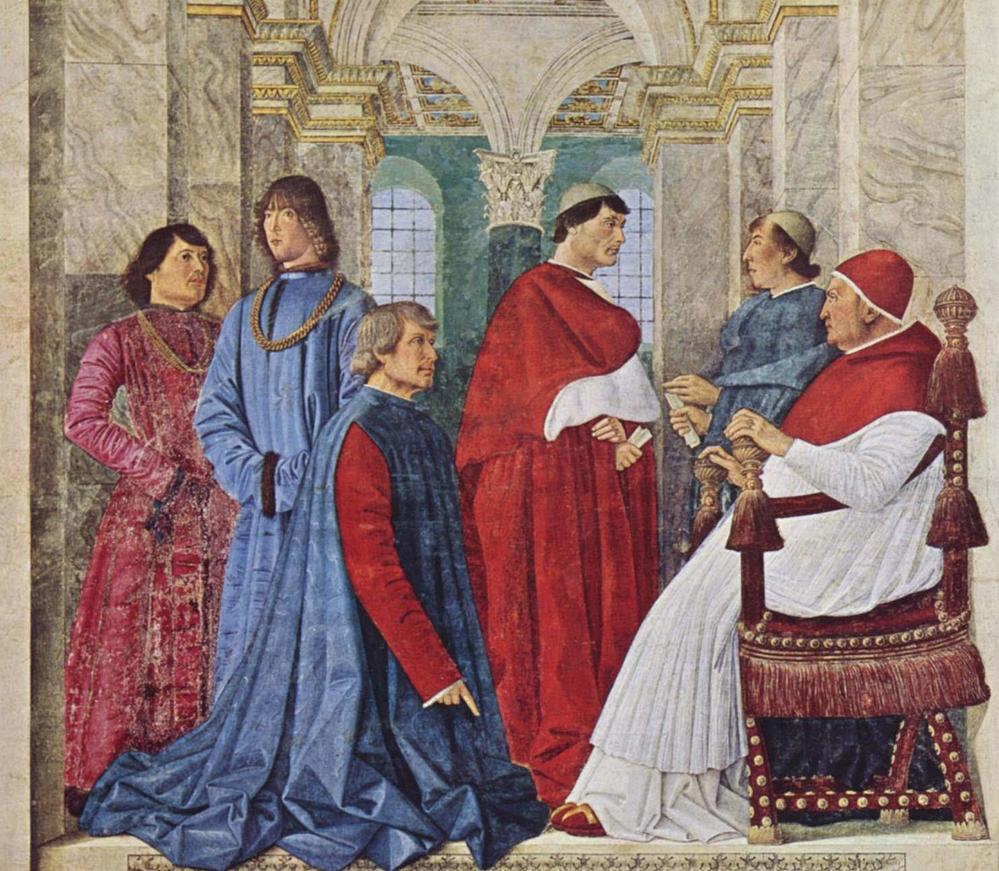
Sixtus IV, seated, is nominating the humanist Bartolomeo Sacchi known as Platina, kneeling before him, prefect of the Vatican Library. At his side is his right-hand man, the powerful Cardinal Pietro Riario, while the young man with the tonsure and ecclesiastical habit in front of him is our future Julius II, but at that moment he’s still only Cardinal Giuliano della Rovere. The two figures on the left are two other nephews of the pope: the first one is Giovanni della Rovere, destined to the civil and military carreer, while the blond man is the greedy and megalomaniac Girolamo Riario, cousin of the aforementioned Pietro and responsible for “accidents” such as the Congiura dei Pazzi or the Ferrara War.
But that’s another story.
- Strange as it may seem, among art historians there were also those, like Zeri or Camesasca, who regretted d’Amelia’s starry vault and found it “more appropriate” to the Chapel. Appealing to freedom of conscience, I declare myself totally in disagreement.
- The insidious terrain below the base shoe and a wrong design of the foundations meant that the chapel underwent other “adjustments”: one in 1522, which caused the collapse of an architrave killing a Swiss guard and missing Pope Adrian VI, and another in 1523 during the conclave.
- And nothing will be done about it for the next forty years between quarrels with the heirs, upheavals of the project and papal interventions. The ghost of Julius II will continue to haunt Michelangelo for much of his life.
- Michelangelo, like Titian, will always be extremely sensitive to the “money” subject.
- According to the famous Augustinian tripartition aimed at dividing history into a first period ante legem (before the law) that goes from the fall to Moses and the Tables of the Law, a second sub lege (under the law) until the birth of Christ and a third sub gratia (under the grace) from Christ until the end of time.
- Grassi, a master of ceremonies since 1504, is the author of the Diaria, a precious collection of information on everything that happened in and around the Vatican from his appointment until December 1521.
